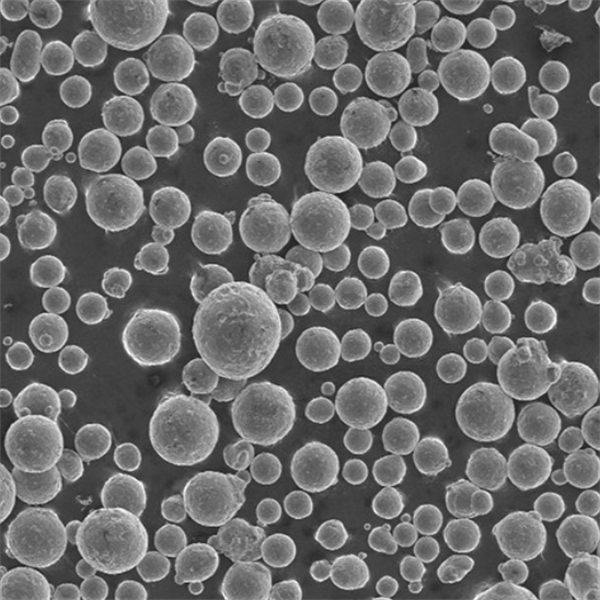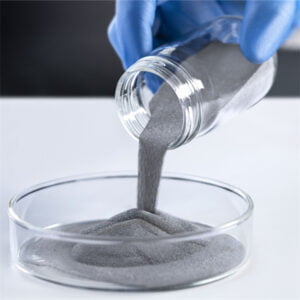Vakuové indukční tavení
Obsah
Přehled
Vakuové indukční tavení (VIM) je sofistikovaný a vysoce přesný proces používaný k výrobě vysoce kvalitních kovových slitin a prášků. Tato metoda je klíčová pro aplikace vyžadující výjimečnou čistotu a přesné složení, takže je nezbytná v průmyslových odvětvích, jako je letectví, zdravotnické přístroje a vysoce výkonné strojírenství. Pojďme se ponořit do složitostí VIM, prozkoumat její procesy, aplikace, výhody, nevýhody a podrobné informace o různých modelech kovových prášků vyráběných touto technikou.
Co je vakuové indukční tavení?
Vakuové indukční tavení zahrnuje tavení kovů ve vakuovém prostředí pomocí elektromagnetické indukce. Tato technika minimalizuje kontaminaci plyny a nečistotami a zajišťuje výrobu kovů s vynikající čistotou a homogenitou. Tavením kovů ve vakuu VIM zabraňuje oxidaci a umožňuje přesnou kontrolu nad složením konečného výrobku.
Klíčové údaje o VIM:
- Proces: Tavení kovů pomocí elektromagnetické indukce ve vakuu.
- Účel: Výroba vysoce čistých kovových slitin a prášků.
- Aplikace: Letectví, zdravotnické přístroje, vysoce výkonné strojírenství.

Jak funguje vakuové indukční tavení
Představte si špičkově vybavenou kuchyň, kde vaříte svůj oblíbený pokrm v dokonale kontrolovaném prostředí bez nežádoucích pachů a nečistot. To je ve zkratce VIM, ale pro kovy! Proces začíná umístěním surovin do kelímku ve vakuové komoře. Kelímek obklopuje indukční cívka, která při průchodu elektrického proudu vytváří magnetické pole. Toto magnetické pole indukuje v kovu vířivé proudy, které způsobují jeho zahřívání a nakonec tavení.
Jakmile kov dosáhne požadované teploty, lze přidat legující prvky, aby se dosáhlo požadovaného složení. Vakuové prostředí zajišťuje, že v tavenině nejsou zachyceny žádné plyny, což vede k čistší a homogennější slitině.
Typy vyráběných kovů a slitin
VIM je všestranný a dokáže vyrábět širokou škálu kovů a slitin. Zde jsou některé konkrétní modely kovových prášků:
- Superslitiny na bázi niklu (např. INCONEL 718)
- Složení: Nikl, chrom, železo a další prvky.
- Vlastnosti: Vysoká pevnost, odolnost proti korozi a vynikající výkon při vysokých teplotách.
- Aplikace: Turbínových lopatek, leteckých součástí.
- Slitiny titanu (např. Ti-6Al-4V)
- Složení: Titan, hliník, vanad.
- Vlastnosti: Vysoký poměr pevnosti a hmotnosti, vynikající odolnost proti korozi.
- Aplikace: Letectví a kosmonautika, lékařské implantáty.
- Slitiny kobaltu a chromu (např. CoCrMo)
- Složení: Kobalt, chrom, molybden.
- Vlastnosti: Vysoká odolnost proti opotřebení, biokompatibilita.
- Aplikace: Lékařské implantáty, zubní zařízení.
- Nerezové oceli (např. 316L)
- Složení: Železo, chrom, nikl, molybden.
- Vlastnosti: Odolnost proti korozi, mechanická pevnost.
- Aplikace: Chirurgické nástroje, námořní aplikace.
- Slitiny hliníku (např. AlSi10Mg)
- Složení: Hliník, křemík, hořčík.
- Vlastnosti: Lehký, dobré tepelné vlastnosti.
- Aplikace: Automobilové díly, letecké a kosmické komponenty.
- Slitiny hořčíku (např. AZ91D)
- Složení: Hořčík, hliník, zinek.
- Vlastnosti: Lehké, vysoce pevné.
- Aplikace: Automobilový průmysl, elektronika.
- Slitiny mědi (např. CuCrZr)
- Složení: Měď, chrom, zirkon.
- Vlastnosti: Vysoká elektrická vodivost, dobré mechanické vlastnosti.
- Aplikace: Elektrické komponenty, výměníky tepla.
- Nástrojové oceli (např. rychlořezná ocel M2)
- Složení: Železo, wolfram, molybden, chrom.
- Vlastnosti: Vysoká tvrdost, odolnost proti opotřebení.
- Aplikace: Řezné nástroje, formy.
- Slitiny drahých kovů (např. PtIr)
- Složení: Platina, iridium.
- Vlastnosti: Vysoká odolnost proti korozi, dobré mechanické vlastnosti.
- Aplikace: Šperky, zdravotnické prostředky.
- Vysoce entropické slitiny (např. CoCrFeNiMn)
- Složení: kobalt, chrom, železo, nikl, mangan.
- Vlastnosti: Vynikající mechanické vlastnosti, vysoká odolnost proti korozi.
- Aplikace: Pokročilé technické aplikace.
Výhody Vakuové indukční tavení
Proč je společnost VIM v metalurgickém světě tak vysoce ceněna? Zde je několik klíčových výhod:
- Vysoká čistota: Vakuové prostředí eliminuje kontaminaci plyny, což vede k získání kovů s výjimečnou čistotou.
- Přesné složení: Umožňuje přesnou kontrolu nad legujícími prvky, čímž vznikají materiály s vlastnostmi na míru.
- Zlepšené mechanické vlastnosti: Kovy vyrobené pomocí VIM vykazují vynikající mechanické vlastnosti.
- Homogenita: Zajišťuje rovnoměrné rozložení legujících prvků v celém kovu.
- Všestrannost: Dokáže tavit širokou škálu kovů a slitin.
Nevýhody vakuového indukčního tavení
Jako každý proces má i VIM své nevýhody. Zde jsou některé z nich:
- Náklady: Náklady na vybavení a provoz VIM jsou poměrně vysoké.
- Složitost: Tento proces vyžaduje sofistikovanou technologii a odborné znalosti.
- Měřítko: V porovnání s jinými metodami tavení je typicky vhodný pro menší dávky.
Aplikace z Vakuové indukční tavení
VIM mění pravidla hry v mnoha odvětvích. Prozkoumejme jeho klíčové aplikace:
Letectví:
- Součásti: Lopatky turbín, části motorů.
- Výhody: Výkon při vysokých teplotách, odolnost.
Lékařské přístroje:
- Součásti: Implantáty, chirurgické nástroje.
- Výhody: Biokompatibilita, odolnost proti korozi.
Vysoce výkonné inženýrství:
- Součásti: Vysoce namáhané komponenty, specializované nástroje.
- Výhody: Pevnost, odolnost proti opotřebení.
Typy kovů a slitin vyráběných společností VIM
| Kov/slitina | Složení | Vlastnosti | Aplikace |
|---|---|---|---|
| INCONEL 718 | Nikl, chrom, železo | Vysoká pevnost, odolnost proti korozi | Turbínových lopatek, leteckých komponentů |
| Ti-6Al-4V | Titan, hliník, vanad | Vysoký poměr pevnosti k hmotnosti, odolnost proti korozi | Letectví a kosmonautika, lékařské implantáty |
| CoCrMo | Kobalt, chrom, molybden | Vysoká odolnost proti opotřebení, biokompatibilita | Lékařské implantáty, zubní zařízení |
| Nerezová ocel 316L | Železo, chrom, nikl, molybden | Odolnost proti korozi, mechanická pevnost | Chirurgické nástroje, námořní aplikace |
| AlSi 10Mg | Hliník, křemík, hořčík | Lehké, dobré tepelné vlastnosti | Automobilové díly, letecké a kosmické komponenty |
| AZ91D | Hořčík, hliník, zinek | Lehké, vysoce pevné | Automobilový průmysl, elektronika |
| CuCrZr | Měď, chrom, zirkonium | Vysoká elektrická vodivost, dobré mechanické vlastnosti | Elektrické komponenty, výměníky tepla |
| Vysokorychlostní ocel M2 | Železo, wolfram, molybden, chrom | Vysoká tvrdost, odolnost proti opotřebení | Řezné nástroje, formy |
| PtIr | Platina, iridium | Vysoká odolnost proti korozi, dobré mechanické vlastnosti | Šperky, zdravotnické prostředky |
| CoCrFeNiMn | Kobalt, chrom, železo, nikl, mangan | Vynikající mechanické vlastnosti, vysoká odolnost proti korozi | Pokročilé technické aplikace |
Použití kovů vyrobených technologií VIM
| Průmysl | Komponenty | Výhody |
|---|---|---|
| Aerospace | Lopatky turbín, části motorů | Výkon při vysokých teplotách, odolnost |
| Lékařské přístroje | Implantáty, chirurgické nástroje | Biokompatibilita, odolnost proti korozi |
| Vysoce výkonné inženýrství | Vysoce namáhané komponenty, specializované nástroje | Pevnost, odolnost proti opotřebení |

Specifikace a normy
| Kov/slitina | Standard | Třída | Specifikace |
|---|---|---|---|
| INCONEL 718 | ASTM B637 | Stupeň 1 | Vysoká pevnost při zvýšených teplotách |
| Ti-6Al-4V | ASTM B348 | 5. třída | Vysoký poměr pevnosti a hmotnosti |
| CoCrMo | ASTM F1537 | Stupeň 1 | Vysoká odolnost proti opotřebení |
| Nerezová ocel 316L | ASTM A240 | Třída 316L | Odolnost proti korozi |
| AlSi 10Mg | ASTM B928 | Stupeň 1 | Lehké, dobré tepelné vlastnosti |
| AZ91D | ASTM B93 | Třída AZ91D | Lehké, vysoce pevné |
| CuCrZr | ASTM B224 | Stupeň 1 | Vysoká elektrická vodivost |
| Vysokorychlostní ocel M2 | ASTM A600 | Třída M2 | Vysoká tvrdost, odolnost proti opotřebení |
| PtIr | ASTM B563 | Stupeň 1 | Vysoká odolnost proti korozi |
| CoCrFeNiMn | ASTM E2209 | Stupeň 1 | Vynikající mechanické vlastnosti |
Výhody a nevýhody Vakuové indukční tavení
Výhody
| Výhoda | Popis |
|---|---|
| Vysoká čistota | Eliminuje kontaminaci plynem a zajišťuje nejvyšší čistotu. |
| Přesné složení | Přesná kontrola legujících prvků pro dosažení vlastností na míru. |
| Zlepšené mechanické vlastnosti | Vynikající mechanické vlastnosti konečných výrobků. |
| Homogenita | Rovnoměrné rozložení legujících prvků. |
| Všestrannost | Vhodné pro širokou škálu kovů a slitin. |
Nevýhody
| Nevýhoda | Popis |
|---|---|
| Náklady | Vysoké náklady na vybavení a provoz. |
| Složitost | Vyžaduje sofistikovanou technologii a odborné znalosti. |
| Měřítko | V porovnání s ostatními metodami jsou obvykle omezeny na menší velikosti dávek. |
Podrobnosti o dodavatelích a cenách
Přední dodavatelé zařízení VIM
| Dodavatel | Sortiment výrobků | Stanovení cen | Region |
|---|---|---|---|
| Skupina Inductotherm | Pece VIM, příslušenství | $100,000 – $1,000,000 | Globální |
| Vakuové technologie ALD | Systémy VIM, řešení na zakázku | $150,000 – $2,000,000 | Globální |
| Seco/Warwick | Pece VIM, poprodejní služby | $120,000 – $900,000 | Severní Amerika, Evropa |
| Consarc | Pece VIM a VAR | $200,000 – $1,500,000 | Globální |
| Technologie ECM | Systémy VIM | $100,000 – $850,000 | Evropa, Asie |
Srovnání VIM a jiných metod tavení
| Aspekt | Vakuové indukční tavení (VIM) | Tavení obloukem | Přetavování elektrostruskou (ESR) |
|---|---|---|---|
| Čistota | Vysoké díky vakuovému prostředí | Mírný | Vysoký |
| Náklady | Vysoký | Dolní | Vysoký |
| Složitost | Vysoký | Mírný | Vysoký |
| Velikost dávky | Malé až střední | Střední až velké | Střední |
| aplikace | Vysoce výkonné slitiny | Obecný účel | Aplikace s vysokou čistotou |

Nejčastější dotazy
| Otázka | Odpovědět |
|---|---|
| Co je vakuové indukční tavení (VIM)? | VIM je proces, při kterém se taví kovy pomocí elektromagnetické indukce ve vakuu a vyrábí se tak vysoce čisté slitiny. |
| Proč používat VIM místo jiných metod tavení? | VIM nabízí vynikající čistotu, přesnou kontrolu složení a lepší mechanické vlastnosti. |
| Jaké kovy lze pomocí VIM vyrábět? | Společnost VIM může vyrábět širokou škálu kovů, včetně superslitin na bázi niklu, titanových slitin a dalších. |
| Jaké jsou hlavní aplikace VIM? | Mezi klíčové aplikace patří letecké komponenty, lékařské přístroje a vysoce výkonné strojírenské díly. |
| Jaké jsou nevýhody VIM? | Mezi nevýhody patří vysoké náklady, složitost a obvykle menší velikosti dávek. |
| Kdo jsou přední dodavatelé zařízení VIM? | Mezi přední dodavatele patří společnosti Inductotherm Group, ALD Vacuum Technologies a Seco/Warwick. |
| Jak se VIM srovnává s tavením obloukem? | VIM poskytuje vyšší čistotu, ale ve srovnání s obloukovým tavením je nákladnější a složitější. |
Závěr
Vakuové indukční tavení je vrcholem moderní metalurgie a poskytuje bezkonkurenční čistotu a přesnost při výrobě kovů. Její aplikace zahrnují kritická průmyslová odvětví, kde je výkon a spolehlivost neoddiskutovatelná. Ačkoli je spojena s vyššími náklady a složitostí, její výhody často převažují nad těmito problémy, což z VIM činí neocenitelný proces ve výrobě pokročilých materiálů.
Sdílet na
MET3DP Technology Co., LTD je předním poskytovatelem řešení aditivní výroby se sídlem v Qingdao v Číně. Naše společnost se specializuje na zařízení pro 3D tisk a vysoce výkonné kovové prášky pro průmyslové aplikace.
Dotaz k získání nejlepší ceny a přizpůsobeného řešení pro vaše podnikání!
Související články

Vysoce výkonné segmenty lopatek trysek: Revoluce v účinnosti turbín díky 3D tisku z kovu
Přečtěte si více "O Met3DP
Nedávná aktualizace
Náš produkt
KONTAKTUJTE NÁS
Nějaké otázky? Pošlete nám zprávu hned teď! Po obdržení vaší zprávy obsloužíme vaši žádost s celým týmem.

Kovové prášky pro 3D tisk a aditivní výrobu
SPOLEČNOST
PRODUKT
kontaktní informace
- Město Qingdao, Shandong, Čína
- [email protected]
- [email protected]
- +86 19116340731
















